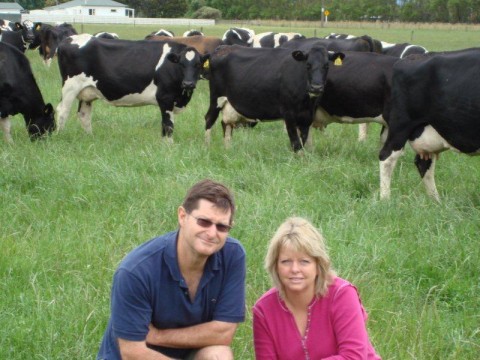Fringe farming
I am fifty three years old and for 3 generations our family has farmed cows on the same farm.
Twenty years ago intensification began replacing traditional farming methods and farmers, like myself, were caught up in this drive to reap more milk.
I call it the ‘moron theory’ – we’re morons the more we put on. We lathered on fertilizer & nitrogen, filled our paddocks with more stock and feed them stuff our grandfathers had never heard of, like palm kernel.
Fonterra in its drive to grow at 4% year on year is pushing its farmers into this unsustainable model. They actually promote the use of palm kernel through their subsidiary RD1.
The welfare of the cows, and the quality of our soils fell by the wayside as we became focused on the pursuit of greater and greater production.
Once upon a time, I was a leading example of a high input farmer. Then I had one of those ahha moments. I realized this is not what life is about, this isn’t a trial run.
As a farmer I want to care about my animals, my land and ultimately people’s health, not go chasing ridiculous milk yields without looking at the consequences.
At that stage I was milking my cows three times a day, pumping my land full of fertilizer, stocking my paddocks to the brink and as a consequence filling them with all number of antibiotics.
Five years ago I was spending $1,200 – 1,500 per month on antibiotics, now I spend next to nothing.
And although I was producing 250,000 kilos of milk solids from a 120 hectare farm, I was stressed and not enjoying farming anymore.
Once the decision was made to move into a more sustainable style of farming I went looking for options. There was organics but I soon discovered Biological farming. This model is underpinned by organic principles but uses modern science and technology to produce nutrient dense food.
I’ve taken up a model of farming that is promoted by American farmer author and lecturer, Joel Salatin – a holistic farming method that exploits symbiotic relationships.
I have chooks that I keep in mobile hen houses and they’re moved from one pasture to another behind the cows.
They play an important role in cleaning up fly-larvae and bugs, spreading manure into the ground and fertilizing the ground with their own droppings. Plus, they give me quality nutrient dense eggs.
Thirty percent of the hen’s diet is fresh pasture and they drink fresh milk everyday.
My paddocks are filled with different herbs and grasses, from clover to rye-grasses and heritage varieties which allows the cows to choose their diet and self-medicate, if necessary.
I admit – I still use fertilizer, but a fraction of the amount I used 5 years ago.
And although I sell less milk (around $200,000 less each year), I save around $400,000 a year by lowering my veterinary bills and spending much less on chemical fertilizer and antibiotics. Also, I need fewer replacement animals because my cows last longer.
Since I started biological farming I have fewer animal health issues and it each year I have fewer problems.
AND I feel much happier knowing that our milk is nutrient-filled as well.
Now I can sleep at night because I know I am not running an entirely unsustainable operation. I am a born again farmer.
Biological farming is still a fringe activity. However, soon I hope, there will be a tipping point so this style of farming will become adopted by a new generation of farmers.
Little by little, more and more people are becoming aware of the relationship between the quality of their food and their health.
I believe our job as farmers is like a builder, if a builder gets his foundation right then he can build a sky scraper and if a farmer gets his foundation (the soil) right, as nature intended, then the sky’s the limit!
Jeff Williams will be a speaker at our 2012 Face the Future conference.

